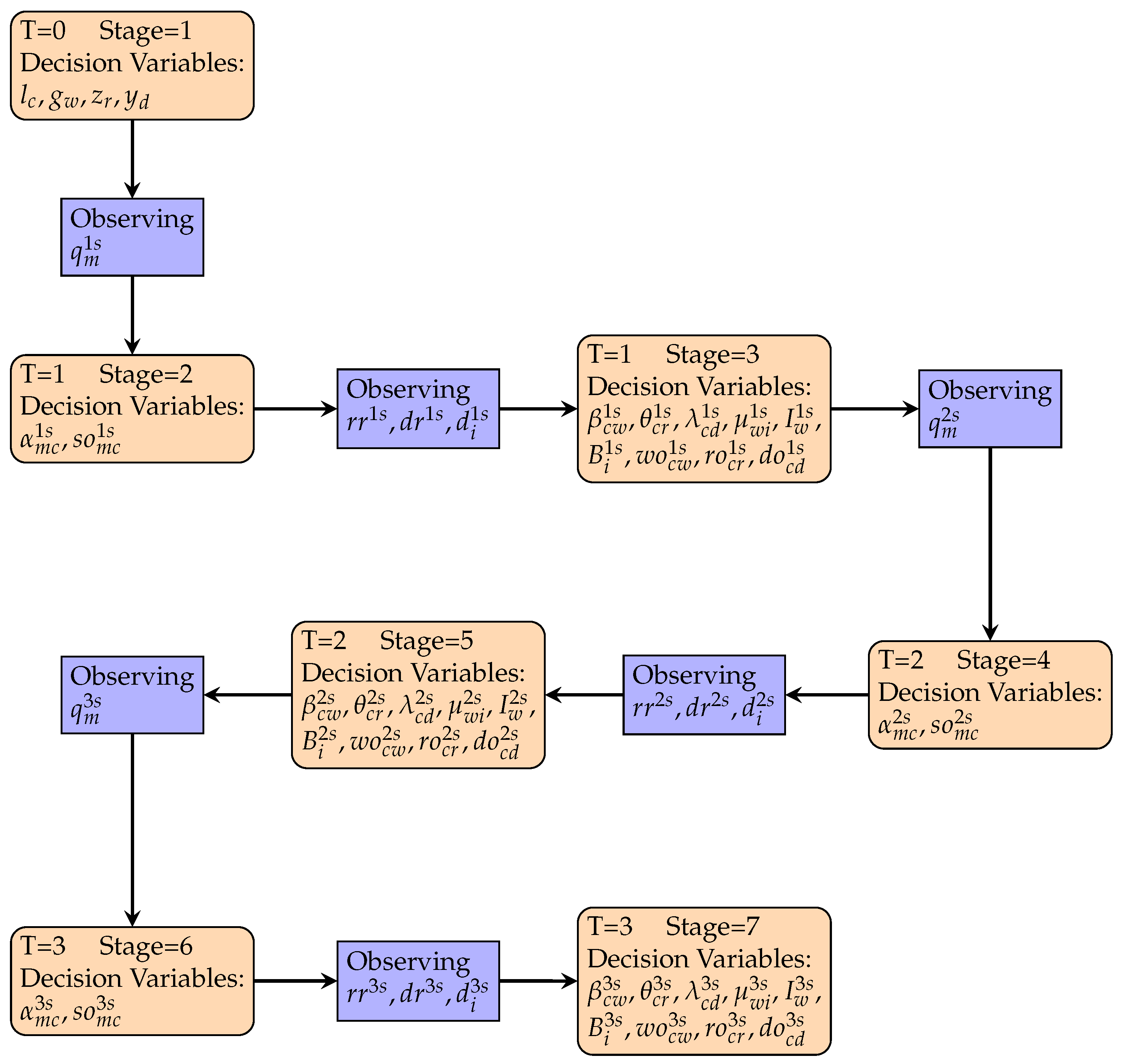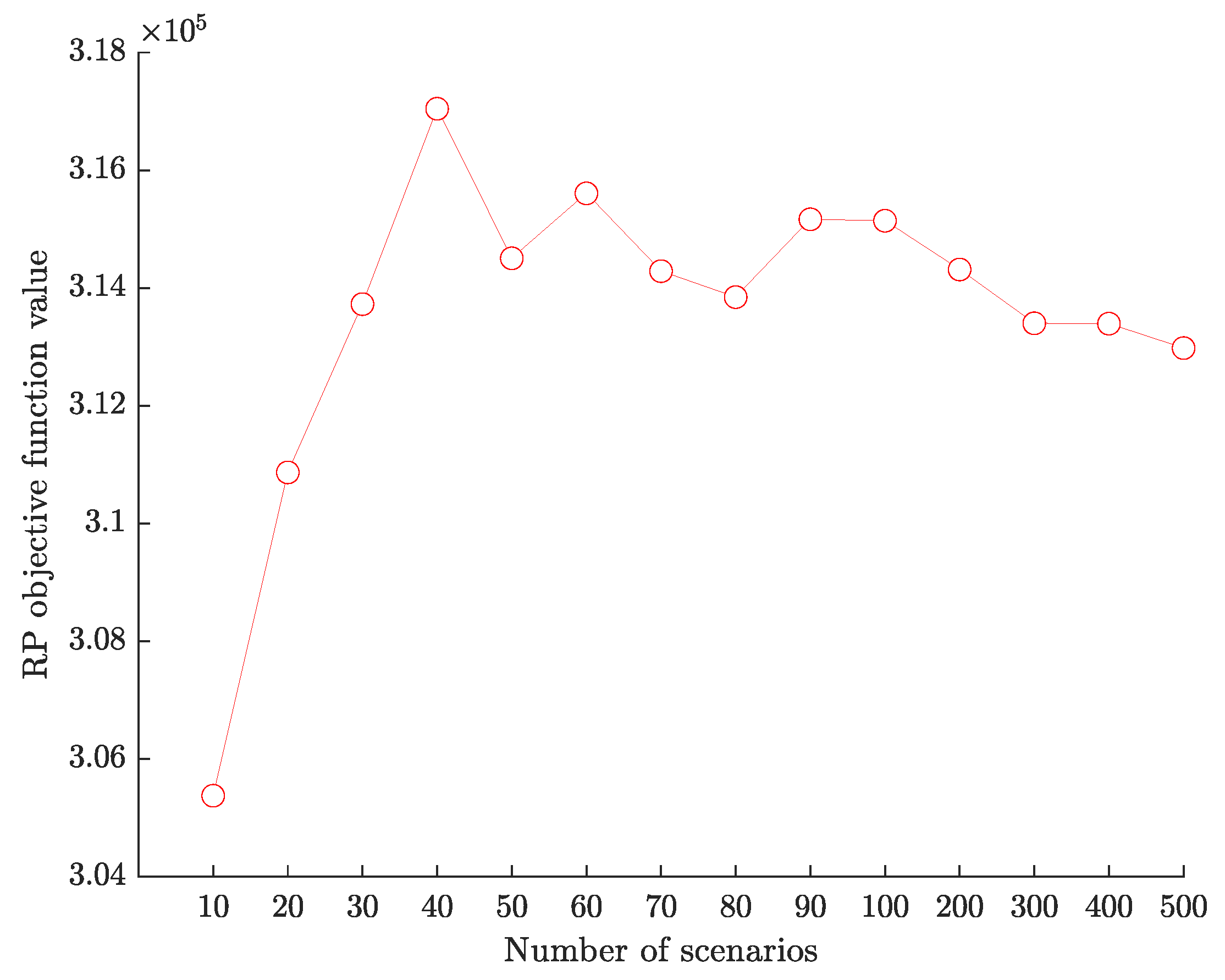Reverse logistics has been gaining popularity in recent years. A great portion of reverse logistics literature has been devoted to deterministic reverse logistics problems. Ref. [
5] formulated a multi-stage reverse logistics network for product recovery as a mixed integer linear programming model. The authors validated the model with a used refrigerator recovery network. Ref. [
6] developed a nonlinear mixed-integer linear programming model for a reverse logistics network which makes decisions on the number and locations of centralized return centers. They proposed a genetic algorithm to solve the formulated model. Ref. [
7] proposed a mathematical model for a multi-stage, multi-product reverse logistics network. The authors developed a hybrid heuristic based on genetic algorithm for solving the introduced model. Ref. [
8] studied a reverse logistics network for a company located in Brazil. They developed a returnable packaging model which decreases material consumption by 18% compared to disposable packaging model. In addition, they concluded that returnable packaging model is the best alternate in terms of environmental concerns since it has less environmental impacts compared to disposable packaging models. Ref. [
9] addressed a reverse logistics network for end-of-live vehicles in Turkey. The authors proposed a mixed-integer linear programming model for the network. Solving the model led to the optimal number of facilities to be located. Ref. [
10] formulated a reverse logistics network for a case of household appliance in the Gulf Cooperation Council (GCC) region with 68 cities. The authors developed a genetic algorithm with running time reduction up to 38 times compared to GMAS in solving the problem. Ref. [
11] studied a multi-echelon capacitated reverse logistics network with location-routing, and time window constraints. The authors formulated the problem as a bi-objective mathematical programming model and proposed a non-dominated sorting genetic algorithm II (NSGA II) to obtain Pareto frontier solutions.
Compared to traditional forward logistics, more activities are involved in reverse logistics planning which makes it more challenging. One of the challenges in designing reverse logistics network is the presence of several uncertain factors such as return and demand quantities, and return quality. Therefore considering uncertainty and designing a robust decision making framework are crucial for reverse logistics design. Ref. [
12] combined queuing models with traditional reverse logistics models to incorporate lead time and inventory positions in an uncertain environment. This combination led to a mixed integer nonlinear programming model. The authors solved the formulated model by a genetic algorithm with the technique of differential evolution. While most of the studied models in reverse logistics are case based, ref. [
13] proposed a generalized model considering capacity limits, multi-product management, and uncertainty in demand and return quantities. They solved the formulated model by standard branch and bound techniques. Ref. [
14] studied a risk-averse, two-stage stochastic programming approach reverse logistic network design problem. They considered return quantity and price as two sources of uncertainty. Ref. [
15] focused on a reverse logistics problem with decisions on inventory control and production planning. They considered return and demand quantities as two stochastic parameters and modelled them using fuzzy trapezoidal numbers. The authors developed a two phase fuzzy mixed integer optimization algorithm to solve the formulated model. Ref. [
16] studied a reverse logistics network with three uncertainty sources: return quantity, return quality, and transportation cost. They formulated the problem as a two-stage stochastic programming model and validated it by a real world case for waste of electrical and electronic equipment recycling center in Turkey. The authors used sample average approximation method to solve the model. Ref. [
17] proposed a dynamic location and allocation model for reverse logistic problem and formulated it as a two stage stochastic programming model. Also, they developed a heuristic solution method based on sampling to solve the model. Ref. [
18] studied a multi-period reverse logistics network under return and demand uncertainty with lot sizing and formulated it as a two-stage stochastic programming model. They used scenario generation and scenario reduction methods to generate sets of discrete scenarios to approximate underlying probability distributions. The authors used a case of consumer company in Europe to validate the proposed model. Ref. [
19] designed an International Reverse Logistics (IRL) network under uncertainty. Authors used Japanese case study to formulate a resilient and efficient IRL model to minimize the total cost of system subject to resilience constraints. Ref. [
20] designed a two-stage stochastic programming model for eco-efficient reverse logistics problem to minimize landfilling activities and maximize expected profit. In their study, recycling rates and the quantity of generated waste are considered as two main sources of uncertainties. Authors implemented Sampling Average Approximation process and
-constrained method to solve the formulated problem. They used a wood waste recycling case study in province of Quebec in Canada. Ref. [
21] designed a reverse logistics network for recycling construction and demolition wastes. They proposed a multi-objective, multi-period mixed integer programming model for this network design problem. Authors included two uncertain factors in this reverse logistics network: rate of investment and recycled products demand. Risk averse two-stage stochastic programming model was used to solve the model under uncertainty. Ref. [
22] present a stochastic mixed integer programming model for designing and planning a generic multi-source, multi-echelon, capacitated, and sustainable reverse logistics network for WEEE management under uncertainty. Their model takes into account both economic efficiency and environmental impacts in decision-making, and the environmental impacts are evaluated in terms of carbon emissions. Authors employed a multi-criteria two-stage scenario-based solution method for generating the optimal solution for the stochastic optimization problem. Ref. [
23] models the electrical and electronic equipment (EEE) reverse logistics process as a bi-objective mixed-integer programming model under uncertainties. Their mathematical model investigates two objectives: an economic objective and an environmental objective. The first is minimizing cost, while the second is maximizing the environmental score by reverse logistics processes in recovering and recycling. The parameters of demand and WEEE return rate which is obtained from the customer were considered as two uncertain parameters. Ref. [
24] identifies reverse logistics barriers through (1) an extent literature review, (2) advice from Bangladeshi industry experts under the Delphi study, and (3) ranking reverse logistics barriers using the fuzzy analytical hierarchy process. The results indicate that, of the barriers investigated, the ‘knowledge and support’ category seems to be most critical. A lack of interest and support from top-level management—related to ‘knowledge and support’ issues—appears to be the major obstacle for reverse logistics implementation in the Bangladeshi leather footwear industry. Ref. [
25] applied Interpretive Structural Modeling (ISM) technique to diagnose significant barriers and proposed a hierarchical framework for investigating the relationships among them. They used MICMAC (Matriced’ Impacts Croisés Multiplication Appliquée á unClassement) analysis to classify the barriers based on the driving power and dependence among them.












